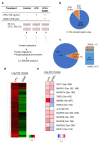S-allylmercaptocysteine inhibits TLR4-mediated inflammation through enhanced formation of inhibitory MyD88 splice variant in mammary epithelial cells
- PMID: 39609525
- PMCID: PMC11604973
- DOI: 10.1038/s41598-024-81304-2
S-allylmercaptocysteine inhibits TLR4-mediated inflammation through enhanced formation of inhibitory MyD88 splice variant in mammary epithelial cells
Abstract
Mastitis is an inflammatory disease affecting mammary tissues caused by bacterial infection that negatively affects milk quality and quantity. S-Allylmercaptocysteine (SAMC), a sulfur compound in aged garlic extract (AGE), suppresses lipopolysaccharide (LPS)-induced inflammation in mouse models and cell cultures. However, the mechanisms underlying this anti-inflammatory effect remain unclear. In this study, we demonstrated that oral administration of AGE suppressed the LPS-induced immune response in a mastitis mouse model and that SAMC inhibited LPS-induced interleukin-6 production and nuclear factor κB p65 subunit activation in HC11 mammary epithelial cells. Global phosphoproteomic analysis revealed that SAMC treatment downregulated 910 of the 1,304 phosphorylation sites upregulated by LPS stimulation in mammary cells, including those associated with toll-like receptor 4 (TLR4) signaling. Additionally, SAMC decreased the phosphorylation of 26 proteins involved in pre-mRNA splicing, particularly the U2 small nuclear ribonucleoprotein complex. Furthermore, we found that SAMC increased the production of the myeloid differentiation factor 88 short form (MyD88-S), an alternatively spliced form of MyD88 that negatively regulates TLR4 signaling. These findings suggest that SAMC inhibits TLR4-mediated inflammation via alternative pre-mRNA splicing, thus promoting MyD88-S production in mammary epithelial cells. Therefore, SAMC may alleviate various inflammatory diseases, such as mastitis, by modulating immune responses.
© 2024. The Author(s).
Conflict of interest statement
Declarations. Competing interests: M.T., M.K., H.T., and J.I.S. are employed by Wakunaga Pharmaceutical Co., Ltd., and F.Q.Z. is employed by University of Vermont as listed in the affiliation section. The employment does not affect each researcher’s conceptualization, design, data collection, analysis, decision to publish, or preparation of the manuscript. This study revealed the new biological activity of SAMC in the experiment systems. The company and the University have no financial interest in this publication.
Figures





Similar articles
-
MyD88 deficiency in mammary epithelial cells attenuates lipopolysaccharide (LPS)-induced mastitis in mice.Biochem Biophys Res Commun. 2024 Dec 20;739:150569. doi: 10.1016/j.bbrc.2024.150569. Epub 2024 Aug 19. Biochem Biophys Res Commun. 2024. PMID: 39186869
-
β-Glucan modulates the lipopolysaccharide-induced innate immune response in rat mammary epithelial cells.Int Immunopharmacol. 2013 Feb;15(2):457-65. doi: 10.1016/j.intimp.2012.12.007. Epub 2012 Dec 20. Int Immunopharmacol. 2013. PMID: 23261364
-
Magnolol inhibits the inflammatory response in mouse mammary epithelial cells and a mouse mastitis model.Inflammation. 2015 Feb;38(1):16-26. doi: 10.1007/s10753-014-0003-2. Inflammation. 2015. PMID: 25173887
-
Nuciferine alleviates LPS-induced mastitis in mice via suppressing the TLR4-NF-κB signaling pathway.Inflamm Res. 2018 Dec;67(11-12):903-911. doi: 10.1007/s00011-018-1183-2. Epub 2018 Aug 25. Inflamm Res. 2018. PMID: 30145653
-
6-Bromoindirubin-3'-Oxime Suppresses LPS-Induced Inflammation via Inhibition of the TLR4/NF-κB and TLR4/MAPK Signaling Pathways.Inflammation. 2019 Dec;42(6):2192-2204. doi: 10.1007/s10753-019-01083-1. Inflammation. 2019. PMID: 31599382
References
-
- Heikkilä, A. M., Liski, E., Pyörälä, S. & Taponen, S. Pathogen-specific production losses in bovine mastitis. J. Dairy Sci.101, 9493–9504 (2018). - PubMed
-
- Bobbo, T. et al. Associations between pathogen-specific cases of subclinical mastitis and milk yield, quality, protein composition, and cheese-making traits in dairy cows. J. Dairy Sci.100, 4868–4883 (2017). - PubMed
MeSH terms
Substances
LinkOut - more resources
Full Text Sources
Medical

